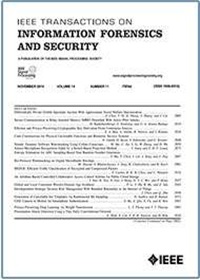Federated Radio Frequency Fingerprint Identification Powered by Unsupervised Contrastive Learning
IF 6.3
1区 计算机科学
Q1 COMPUTER SCIENCE, THEORY & METHODS
IEEE Transactions on Information Forensics and Security
Pub Date : 2024-09-27
DOI:10.1109/TIFS.2024.3469820
引用次数: 0
Abstract
Radio frequency fingerprint identification (RFFI) is a promising physical layer authentication technique that utilizes the unique impairments within the analog front-end of transmitters as distinct identifiers. State-of-the-art RFFI systems are frequently powered by deep learning, which requires extensive training data to ensure satisfactory performance. However, current RFFI studies suffer from a severe lack of training data, which poses challenges in achieving high identification accuracy. In this paper, we propose a federated RFFI system that is particularly suitable for Internet of Things (IoT) networks, which holds a high potential to address the data scarcity challenge in RFFI development. Specifically, all the receivers in an IoT network can pre-train a deep learning-driven feature extractor in a federated and unsupervised manner. Subsequently, a new client can perform fine-tuning on the basis of the pre-trained feature extractor to activate its RFFI functionality. Extensive experimental evaluation was carried out, involving 60 commercial off-the-shelf (COTS) LoRa transmitters and six software-defined radio (SDR) receivers. The experimental results demonstrate that the federated RFFI protocol can effectively improve the identification accuracy from 63% to 95%, and is robust to receiver hardware and location variations.以无监督对比学习为动力的联合射频指纹识别技术
射频指纹识别(RFFI)是一种前景广阔的物理层身份验证技术,它利用发射机模拟前端内的独特损伤作为不同的标识符。最先进的射频指纹识别系统通常由深度学习提供动力,而深度学习需要大量的训练数据才能确保令人满意的性能。然而,目前的 RFFI 研究严重缺乏训练数据,这给实现高识别精度带来了挑战。在本文中,我们提出了一种特别适用于物联网(IoT)网络的联合 RFFI 系统,该系统极有可能解决 RFFI 开发中的数据稀缺难题。具体来说,物联网网络中的所有接收器都能以联合和无监督的方式预先训练深度学习驱动的特征提取器。随后,新客户端可以在预训练特征提取器的基础上进行微调,以激活其 RFFI 功能。我们进行了广泛的实验评估,涉及 60 个商用现成(COTS)LoRa 发射器和 6 个软件定义无线电(SDR)接收器。实验结果表明,联合 RFFI 协议能有效地将识别准确率从 63% 提高到 95%,并且对接收器硬件和位置变化具有鲁棒性。
本文章由计算机程序翻译,如有差异,请以英文原文为准。
求助全文
约1分钟内获得全文
求助全文
来源期刊

IEEE Transactions on Information Forensics and Security
工程技术-工程:电子与电气
CiteScore
14.40
自引率
7.40%
发文量
234
审稿时长
6.5 months
期刊介绍:
The IEEE Transactions on Information Forensics and Security covers the sciences, technologies, and applications relating to information forensics, information security, biometrics, surveillance and systems applications that incorporate these features
 求助内容:
求助内容: 应助结果提醒方式:
应助结果提醒方式:


